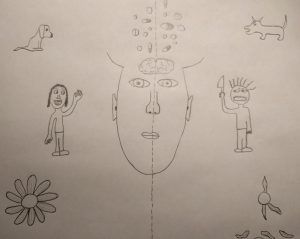
Schizophrenia is a severely debilitating disease for one’s psyche. Unfortunately, the only thing we have to separate reality from nightmares for individuals with this disease is constant use of mind-numbing anti psychotics.
What is the disease?
Schizophrenia is a psychiatric disease that results in severe impairments in daily life. Some common positive symptoms of schizophrenia are delusions, hallucinations, and disorganized thinking. This means that the person has a difficult time producing a normal perception of the world. Many see or hear things that are not there and have abnormal beliefs or paranoia. Some common negative symptoms of schizophrenia are lack of hygiene, reduced eye contact, and lack of emotion. The combination of all of these symptoms make it very difficult to live a normal life and people with schizophrenia are often medicated all of their life to improve these symptoms.
Looking beyond the symptoms
Recent research on the neural cause of schizophrenia has uncovered some clues as to why this disease occurs. The Wnt pathway in neurochemistry is a sequence of cellular events often used to facilitate the development of the central nervous system. It controls the amount of β-catenin in the cytosol of neurons which is a useful molecule for the transcription of developmental genes. It is believed that this Wnt pathway is abnormal in schizophrenia patients causing abnormalities in brain development. Neurons end up connecting incorrectly in the pre-frontal cortex and result in many of the common schizophrenic symptoms.
How should this disease be addressed in the future?
Reducing the severity of schizophrenic symptoms is all we have at this point in the treatment of schizophrenia. Anti psychotics are used to essentially “numb” the person from their positive symptoms to better help them to connect to reality. However, these drugs to not treat the disease at its source. The abnormal brain connections seen in schizophrenia still exist while anti psychotics are being used leaving the person still susceptible to emotional and social impairments. Although the use of anti psychotics is helpful for some symptoms, it is in no way a cure.

In the future, it may be beneficial to look deeper into the underlying causes of this disease. Recent research has uncovered many things that we did not know about schizophrenia but has created just as many new questions. What genes are involved? How is development changed from abnormal Wnt signaling? What specific brain regions are impacted? All of these questions need to be answered more entirely to begin developing a cure for this disease. Rewiring an adult brain is a tall order and perhaps we will never get to the point of curing this disease but will find effective ways at preventing it. Targeting the Wnt pathway specifically may bring new light in the treatment of schizophrenia. Perhaps at an early age everyone would get a checkup on their risk of getting the disease based on gene expression tests. We would then know if Wnt would need to be inhibited or activated to prevent abnormal development.
It has become very apparent that the neural mechanism of schizophrenia is unimaginably complex. No one in the world can tell you exactly what is going on in the brains of schizophrenic patients but one thing is certain; further research is necessary to effectively treat and prevent this disease. Treatments we have today do help but have limits. People on anti psychotics essentially have their personalities taken away from while being numbed with schizophrenic drugs. Sure their positive symptoms improve but they are stripped of who they are as a person. It is important for us to understand how treatments of complex diseases like schizophrenia have consequences that we do not always think about.